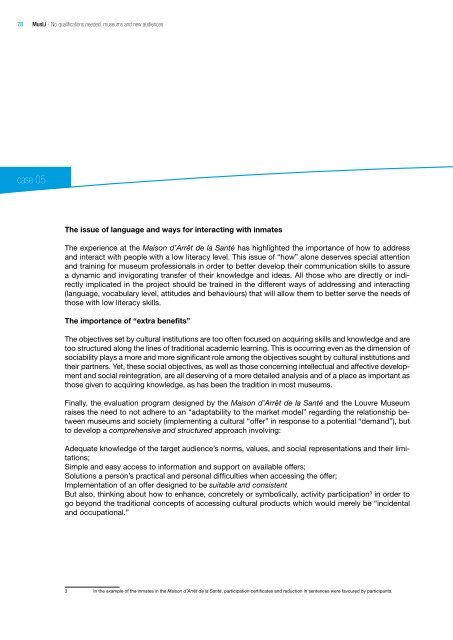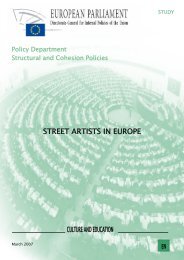MusLi (Museums Literacy) - Fondazione Fitzcarraldo
MusLi (Museums Literacy) - Fondazione Fitzcarraldo
MusLi (Museums Literacy) - Fondazione Fitzcarraldo
You also want an ePaper? Increase the reach of your titles
YUMPU automatically turns print PDFs into web optimized ePapers that Google loves.
78 <strong>MusLi</strong> - No qualifications needed: museums and new audiences<br />
case 05<br />
The issue of language and ways for interacting with inmates<br />
The experience at the Maison d’Arrêt de la Santé has highlighted the importance of how to address<br />
and interact with people with a low literacy level. This issue of “how” alone deserves special attention<br />
and training for museum professionals in order to better develop their communication skills to assure<br />
a dynamic and invigorating transfer of their knowledge and ideas. All those who are directly or indirectly<br />
implicated in the project should be trained in the different ways of addressing and interacting<br />
(language, vocabulary level, attitudes and behaviours) that will allow them to better serve the needs of<br />
those with low literacy skills.<br />
The importance of “extra benefits”<br />
The objectives set by cultural institutions are too often focused on acquiring skills and knowledge and are<br />
too structured along the lines of traditional academic learning. This is occurring even as the dimension of<br />
sociability plays a more and more significant role among the objectives sought by cultural institutions and<br />
their partners. Yet, these social objectives, as well as those concerning intellectual and affective development<br />
and social reintegration, are all deserving of a more detailed analysis and of a place as important as<br />
those given to acquiring knowledge, as has been the tradition in most museums.<br />
Finally, the evaluation program designed by the Maison d’Arrêt de la Santé and the Louvre Museum<br />
raises the need to not adhere to an “adaptability to the market model” regarding the relationship between<br />
museums and society (implementing a cultural “offer” in response to a potential “demand”), but<br />
to develop a comprehensive and structured approach involving:<br />
Adequate knowledge of the target audience’s norms, values, and social representations and their limitations;<br />
Simple and easy access to information and support on available offers;<br />
Solutions a person’s practical and personal difficulties when accessing the offer;<br />
Implementation of an offer designed to be suitable and consistent<br />
But also, thinking about how to enhance, concretely or symbolically, activity participation 3 in order to<br />
go beyond the traditional concepts of accessing cultural products which would merely be “incidental<br />
and occupational.”<br />
3 In the example of the inmates in the Maison d’Arrêt de la Santé, participation certificates and reduction in sentences were favoured by participants.






